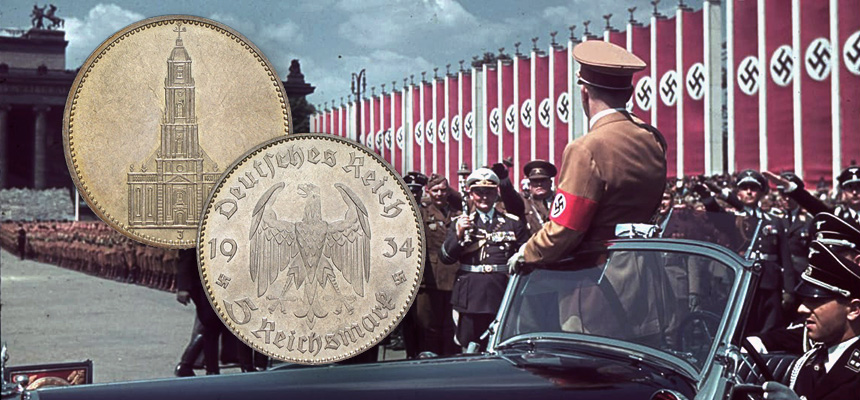The Nazi Commemoratives.
By: MICC Lifetime member #001
Adolph Hitler inherited an in-place, vibrant numismatic market from the very Weimar Republic he helped bury. Since 1925, the Republic had been issuing commemorative silver coins at the rate of one to four issues per year. Even when the mintage-sets were widened to include the products of several different mints, numbers and quality were such that collectors worldwide were generally very satisfied. Designs were attractive if not artistically remarkable; struck in .500 silver, the size of the usual 3- and 5-mark pieces appeared substantial; and mintages were high enough to satisfy all immediate comers, low enough to ensure their “investment” would show future gains.
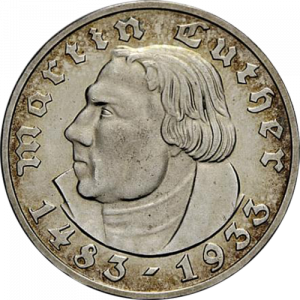
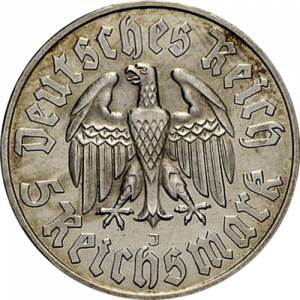
5 Reichsmark, 1933. 450th Anniversary of the birth of Martin Luther. It and its accompanying 2-RM were struck at a total of six mints
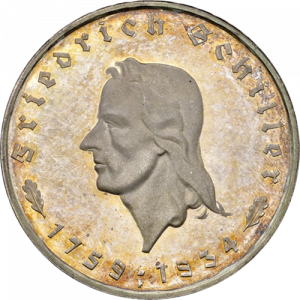
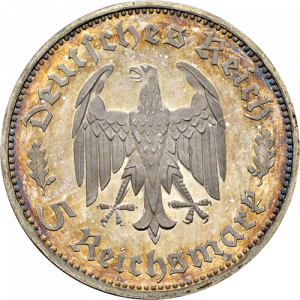
5 RM, 1934. 175th Anniversary of the birth of Schiller. It and its accompanying 2-RM were coined only at the Stuttgart (F) mint.
5 Reichsmark, 1933. 450th Anniversary of the birth of Martin Luther. It and its accompanying 2-RM were struck at a total of six mints. 5 RM, 1934. 175th Anniversary of the birth of Schiller. It and its accompanying 2-RM were coined only at the Stuttgart (F) mint.
After Hitler came to power in March, 1933, the early commemoratives of his regime tended to follow the lines of his Weimar predecessors, the first two being a set of 2- and 5-reichsmark pieces of Martin Luther and a similar set struck in the next year for Schiller. The Luther issue was struck at all six mints (A=Berlin, D=Munich, E=Muldenhütten, F=Stuttgart, G=Karlsruhe, J=Hamburg. After Austria was taken over in 1938, the set was joined by B=Vienna) but the Schiller only at Stuttgart.
But even at the very first, there were some changes made, not all of which were favourably received by collectors in general. For one thing, the finenes was increased from .500 to .900 with a consequent shrinking of the new coins’ size and weight. The artwork also slipped, presumably as a reflection of Hitler’s own tastes and inclinations, having himself been a sort of “bohemian artist” in his younger years just prior to WWI. Designs became very “masculine” – what has been described as an “exaggerated realism” – with overtones of a sort of “comic-book heroism”. In his revulsion against such “decadent art” as impressionism, Hitler was no different from the Soviet Union of the time.
After these two single-year commemoratives, differentiation became blurred between what was a true commemorative and what was a circulating coin. Rather on the cusp was the 1934 issue of 2- and 5-reichsmark pieces commemorating the first anniversary of Nazi rule – 21 March, 1933. The reverses show the broken date (21. März and [swastika] 1933 [swastika]) on either side of the garrison church at Potsdam, a potent symbol of German pride. It was here that Frederick the Great was buried; here that the old Hohenzollern dynasty had worshipped and here that Hitler convened the Reichstag after the fire of February 27, 1933 had destroyed the old parliament buildings. Both the 2- and 5-RM with the date were single-year types and while the 2-RM was not struck again using this design, the 5-RM was. Without the anniversary date, it appeared in both 1934 and 1935 at all six mints and in quantities measured by the millions – in the case of the 1935-A(Berlin), nearly 23½-million being coined.
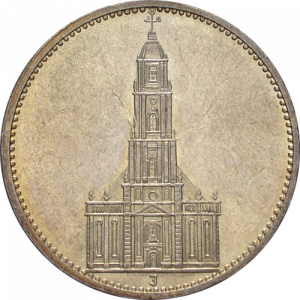
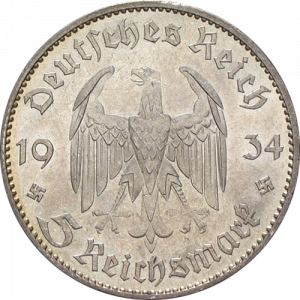
5 RM Potsdam commemorative of 1934, a single year type with the reverse date. Without the date, it was coined in both 1935 and 1935
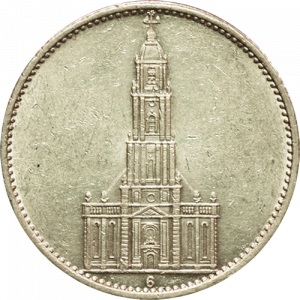
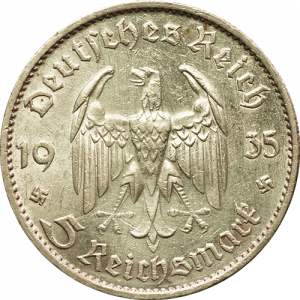
The 2 RM was struck only in 1934 with the split date. All three were produced at all six mints.
It’s quite possible the Type 2 “Potsdam” coins would have been retained for some years as Germany’s circulating silver coins had it not been for the death of Paul von Hindenburg on August 2, 1934. Although Hitler had shunted him aside and done everything to undermine his power, the old field-marshall commanded a vast reservoir of respect and affection among the German people. Hitler then moved to harness that for his own ends. Plans were immediately put under way for a commemorative honouring the Grand Old Man, the first being 5-RM pieces in 1935. These were the “Type 1″s shown below and were minted at all six mints during 1935 and 1936 by the millions and tens of millions.

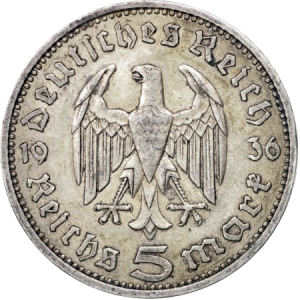
The Hindenburg Commemorative, 1936, with the Type 1 reverse, coined 1935-6.
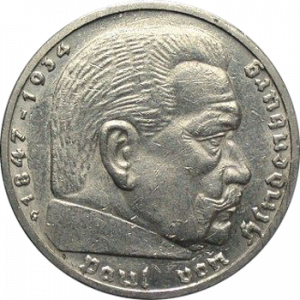
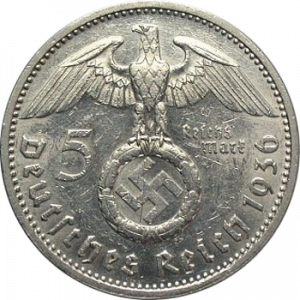
The same obverse used with the Type 2 reverse, coined 1936-9
In a way, Hitler was able to somewhat dishonour Hindenburg even while “honouring” him. The portrait is stark and coarse, giving the impression of a belligerent old man. Late-Weimar patterns and photographs show this was not so.
With Hindenburg dead, the last vestiges of political restraint on Hitler were gone. As of 1936, all German coinage – even down to the lowly Reichspfennig – became overtly Nazi. The Type 1 reverses showing the “Weimar Eagle” were replaced in that year by the Type 2 “Nazi Eagle”, and this remained until 1945.
The silver 2-RM, which had never been issued as a Type-1 Hindenburg, re-joined the ranks with the modified reverse in 1936. Both it and the 5-RM were coined at all six mints – seven as of 1938 when Austria and its Vienna Mint (B) were absorbed into the Reich. Neither were coined after 1939 with the outbreak of the war and while mintage figures are given below, some mean very little since they were quietly withdrawn and the silver diverted to other war needs.

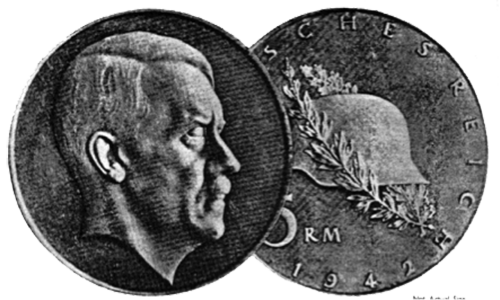
Pattern 5-Reichsmark, 1942. The last contemplated Nazi commemorative.
Previously printed in the MICC Numismatic Journal Vol-02, Issue-06
